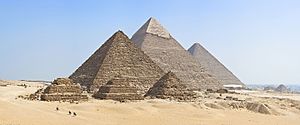
Back طريقة بناء الأهرام المصرية Arabic Teories sobre la construcció de les piràmides Catalan Theorien zum Steintransport beim Bau der ägyptischen Pyramiden German Teorías sobre la construcción de las pirámides Spanish Théories sur la méthode de construction des pyramides égyptiennes French Teorie sulla costruzione delle piramidi egizie Italian Техника строительства египетских пирамид Russian

Egyptian pyramid construction techniques are the controversial subject of many hypotheses. These techniques seem to have developed over time; later pyramids were not constructed in the same way as earlier ones. Most of the construction hypotheses are based on the belief that huge stones were carved from quarries with copper chisels, and these blocks were then dragged and lifted into position. Disagreements chiefly concern the methods used to move and place the stones.
In addition to the many unresolved arguments about the construction techniques, there have been disagreements as to the kind of workforce used. The Greeks, many years after the event, believed that the pyramids were built by slave labour. Archaeologists now believe that the Great Pyramid of Giza (at least) was built by tens of thousands of skilled workers who camped near the pyramids and worked for a salary or as a form of tax payment (levy) until the construction was completed, pointing to workers' cemeteries discovered in 1990.[1] For the Middle Kingdom pyramid of Amenemhat II, there is evidence from the annal stone of the king that foreigners from Canaan were employed.[2]
A number of pseudoscientific theories have been put forth to explain how the pyramids were built.
- ^ Rangus, Eric (29 August 2005). "Egyptologist tells story of commoner pyramid builders". Emory Report. 58 (1). Retrieved 22 April 2024.
- ^ Moussa, Ahmed M. (1991). Altenmüller, Hartwig (ed.). "Die Inschrift Amenemhets II. aus dem Ptah-Tempel von Memphis. Vorbericht" [The inscription of Amenemhet II. From the temple of Ptah of Memphis]. Studien zur Altägyptischen Kultur (in German). 18: 36.
© MMXXIII Rich X Search. We shall prevail. All rights reserved. Rich X Search